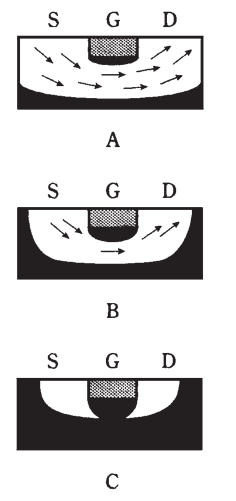Depletion and pinchoff
Either N-channel or P-channel JFET works because voltage at the gate causes an electric field which interferes, more or less, with flow of charge carriers along the channel. A simplified drawing of situation for an N-channel device is shown in the Figure. For the P-channel device, simply interchange polarity (minus/plus) and semiconductor types (N/P).
As drain voltage ED increases, so does drain current ID, up to some specific level off value. This is true as long as gate voltage EG is constant, and is not large negatively.
But as EG becomes increasingly negative, a depletion region (solid black) starts to form in the channel. Charge carriers cannot flow in this region; they should pass through the narrowed channel. The more negative EG becomes, wider the depletion region gets, as shown at point B. Ultimately, if gate becomes negative enough,the depletion region will obstruct flow of charge carriers completely. This is called as pinchoff, and is illustrated at point C.

Figure--At point A, depletion region (solid area) is not wide, and many charge carriers (arrows) flow. At point B, depletion region is wider, channel is narrower, and fewer carriers flow. At point C, channel is completely obstructed, and no carriers flow.
More negative gate voltages, EG, correspond to stepping harder on the hose. When pinchoff takes place, you have cut off the water flow entirely, by bearing down with all your weight on a foot! Biasing beyond the pinchoff is like loading yourself up with heavy weights as you balance on hose, thereby shutting off water flow with extra force.